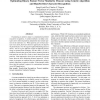Free Online Productivity Tools
i2Speak
i2Symbol
i2OCR
iTex2Img
iWeb2Print
iWeb2Shot
i2Type
iPdf2Split
iPdf2Merge
i2Bopomofo
i2Arabic
i2Style
i2Image
i2PDF
iLatex2Rtf
Sci2ools
ICDAR
2003
IEEE
2003
IEEE
Optimizing Binary Feature Vector Similarity Measure using Genetic Algorithm and Handwritten Character Recognition
Classifying an unknown input is a fundamental problem in pattern recognition. A common method is to define a distance metric between patterns and find the most similar pattern in the reference set. When patterns are in binary feature vector form, there have been two approaches to improve the performance over the equal-weighted Hamming distance metric. One is to give different weights to different features using an optimization technique, and the other is to use a similarity measure that gives full credit to features present in both patterns and the less credit to those absent from both patterns. Both approaches have been reported to perform better than the na¨ıve Hamming distance approach. In this paper, we propose to combine these two approaches using a genetic algorithm to optimize weights. Experimental results show that this method is superior to conventional measures in an OCR application. Key words: Handwriting Recognition, Nearest neighbor, Genetic Algorithm, Similarity Meas...
| Added | 04 Jul 2010 |
| Updated | 04 Jul 2010 |
| Type | Conference |
| Year | 2003 |
| Where | ICDAR |
| Authors | Sung-Hyuk Cha, Charles C. Tappert, Sargur N. Srihari |
Comments (0)

